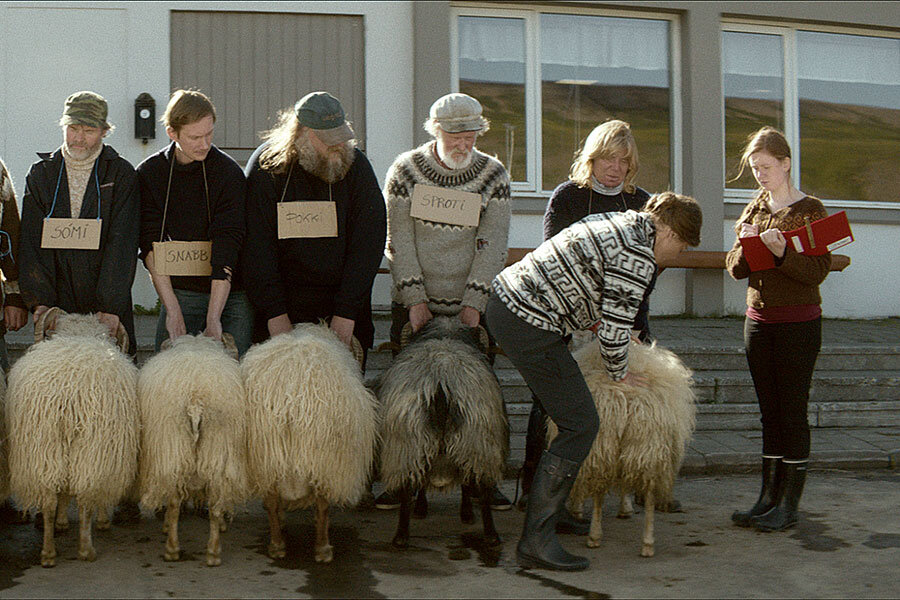'Rams' is a one-of-a-kind movie because of its unusual subject and shape-shifty tone
Loading...
Two estranged fraternal Icelandic sheep farmers might not seem like the most promising of movie subjects. Think again. “Rams,” a 2015 Cannes favorite written and directed by Grímur Hákonarson, is a one-of-a-kind movie, not only because of its subject but also because of its shape-shifty tone. It’s a deadpan tragicomedy in which the humor arises from those bleak landscapes as wispily as chimney smoke from a cottage on a cold night.
Brothers Gummi (Sigurður Sigurjónsson) and Kiddi (Theodór Júlíusson), both unmarried and childless, live side by side in a secluded valley, where each man tends his own prized sheep, descended from the ancestral flock.
For reasons that are unexplained, they have not spoken in 40 years, but their dynamic is clear: Gummi is the teetotaling one, seemingly reasonable; Kiddi, a heavy drinker, is rash and bellicose. Both have voluminous beards that give them an archetypal, Old Testament look. Both, rivalrous of each other, are deeply engaged in tending their flock. Each seems resigned to, even comfortable with, loneliness. (It’s a tribute to the actors that they are able to convey so much while uttering so little.)
After finishing a close second to Kiddi in the annual competition for best ram, Gummi suspects there is something wrong with his brother’s flock, and, after some covert poking around, concludes that the sheep are afflicted with scrapie, a lethal disease of the brain and spinal cord that is said to be unpreventable and incurable. Kiddi does not react well to this news, soon confirmed by veterinarians, and shoots out his brother’s windows, forcing Gummi to relocate to the cellar. But there is no escaping the vets’ verdict: Everybody’s flock in the valley, not just the brothers’, has to be slaughtered.
When the movie started out, I took it to be one of those quirky, low-key, Scandinavian-style jests (I’m thinking especially of the Norwegian Bent Hamer’s “Kitchen Stories”), and certainly there are elements of that sort of thing here. We see it in the sequences with the neighboring farmers who gather and recite paeans to sheep, or with those bachelor brothers whose only grudging method of communication is Kiddi’s dog, who scampers back and forth between the farms as a note-carrying go-between.
But there is a serious undertow even early on. The wide, barren landscape seems strangely unforgiving, a place where obsessions and feuds, unimpeded by distractions, might predictably go out of control. (It’s likely that Gummi and Kiddi, if asked, couldn’t even remember what touched off their feud.) The scrapie diagnosis upturns the entire valley, since most of its inhabitants make their living solely from sheep. And sheep, for these people, are quasi-human animals. Grímur, a documentarian who knows this region well, understands the tender affinity these farmers have for their flock.
[Editor's note: The original version of this review referred to the film's director by his patronym rather than by his first name.]
Dispensing with the sort of barnyard folk humor you might expect from this story, he brings out the fierce pride the brothers have for their prize sheep, and their palpable devastation at having to destroy them – well, not quite all of them. From his herd of 147 sheep, Gummi manages to secrete a few favorites in his basement.
The unspoken subtext to all this is that Gummi and Kiddi, like their sheep, are threatened with dissolution. The lineage of their prize flock goes back many generations, and, through their sheep, we sense that these men feel ennobled by their linkage to the mythic traditions of the past.
It is Kiddi who has the most trouble comprehending the impending disaster. Despite everything, Gummi comes to the aid of his brother, at first almost accidentally and then, finally, in a sequence that is so quietly and devastatingly powerful that it banishes from the film every trace of levity and brings it into the realm of greatness.
“Rams” confirms what I have long maintained: Often the best films come from the unlikeliest places. Grade: A- (Rated R for language, brief graphic nudity.)





